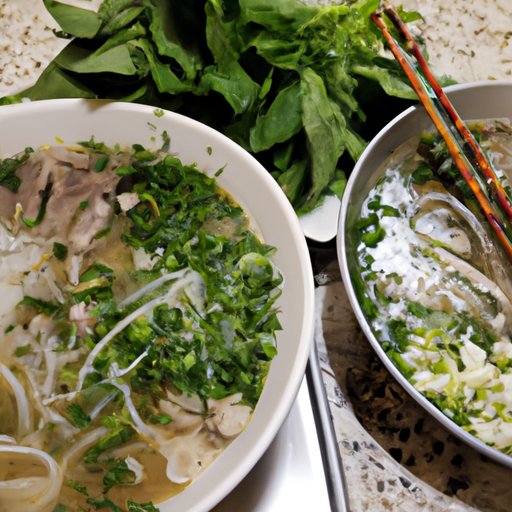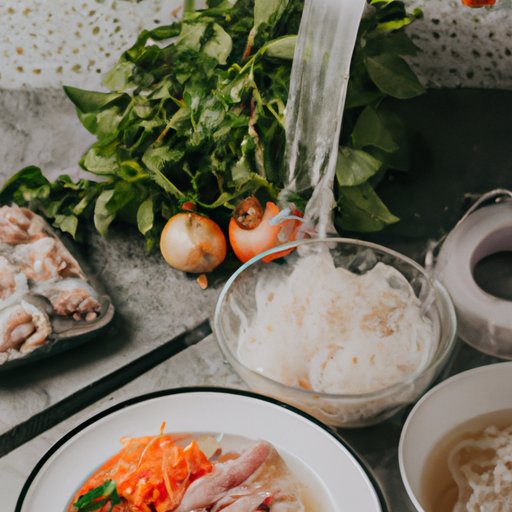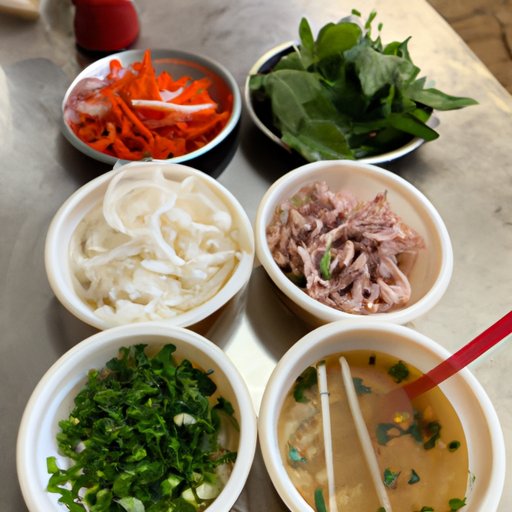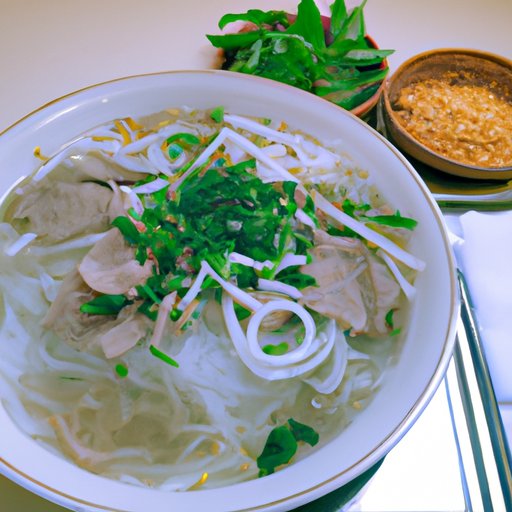Introduction
Pho is a traditional Vietnamese soup that has become increasingly popular in recent years. It’s made with broth, rice noodles, herbs and spices, and usually topped with meat or tofu. But is pho actually healthy for you? In this article, we’ll explore the nutritional benefits and potential risks associated with eating pho, as well as the healthiest toppings to add to your bowl.
Exploring the Nutritional Benefits of Pho
Pho can be an excellent source of vitamins, minerals and other essential nutrients. According to registered dietitian Rachel Stahl, “Pho is a great source of protein, which helps build strong muscles, bones, and skin. It also contains several important vitamins and minerals, including iron, zinc, B vitamins, and vitamin A.”
The broth used to make pho is often made with beef bones, which are rich in collagen and other beneficial compounds like glucosamine. These compounds can help to support joint health and improve digestion. The vegetables and herbs used to make pho can also provide additional vitamins and minerals, such as vitamin C and magnesium.
An In-Depth Look at Pho’s Health Profile
Let’s take a closer look at the macronutrient content of pho. One cup of pho typically contains about 190 calories, 6 grams of fat, 28 grams of carbohydrates and 12 grams of protein. This makes it a relatively low-calorie and low-fat meal option. It’s also a good source of complex carbohydrates, which provide sustained energy and help to keep you full longer.
When it comes to vitamins and minerals, pho is a great source of iron, zinc, B vitamins and vitamin A. Iron helps to transport oxygen throughout the body, while zinc helps to boost the immune system and support wound healing. B vitamins are essential for energy production and metabolism, and vitamin A is important for vision, bone growth and cell differentiation.

The Pros and Cons of Eating Pho
Like any food, there are both advantages and disadvantages to eating pho. On the plus side, it’s a great source of protein, vitamins and minerals. It’s also relatively low in calories and fat, making it a suitable meal option for those trying to lose weight. Additionally, the broth used to make pho can provide beneficial compounds like collagen and glucosamine.
On the downside, pho can be high in sodium. The average bowl of pho contains around 1000 milligrams of sodium, which is more than half of the recommended daily intake. Additionally, some brands of pho may contain MSG, which can cause headaches, dizziness, and other symptoms in some people. Finally, pho is usually made with white rice noodles, which are not as nutritious as whole grain noodles.
Examining the Health Risks of Eating Pho
Eating too much pho can increase your risk of certain health conditions. For example, the high sodium content of pho can contribute to high blood pressure and other cardiovascular problems. Additionally, MSG can cause headaches, dizziness and other symptoms in some people. Finally, the white rice noodles used in pho are not as nutritious as whole grain noodles, so they may not provide the same health benefits.

How to Make a Healthy Version of Pho
If you’re looking to make a healthier version of pho, there are a few simple steps you can take. First, try to choose leaner cuts of meat, such as chicken, pork or turkey. Also, opt for low-sodium broth, as this will help to reduce the amount of sodium in your meal. Finally, add extra vegetables and herbs to your pho, as these will provide additional vitamins and minerals.
Is Pho Good For You? A Nutritionist Weighs In
Registered dietitian Rachel Stahl says that, “Pho can be a healthy part of a balanced diet when eaten in moderation. When choosing what ingredients to put in your pho, opt for leaner cuts of meat, low-sodium broth and plenty of vegetables and herbs.” She also recommends adding plenty of fresh herbs and lime juice to your bowl, as these will add flavor without adding extra calories or sodium.

The Healthiest Toppings for Your Pho Bowl
When topping your bowl of pho, try to choose toppings that are low in calories and sodium. Sprouts, fresh herbs, lime juice, hot sauce, bean sprouts and peanuts are all great options. They’ll add flavor and crunch to your bowl without adding unnecessary calories or sodium.
Conclusion
In conclusion, pho can be a healthy part of a balanced diet when eaten in moderation. It’s a great source of protein, vitamins and minerals, and the broth used to make pho can provide beneficial compounds like collagen and glucosamine. However, it’s important to watch out for the sodium and MSG content of pho, and to choose leaner cuts of meat, low-sodium broth and plenty of fresh vegetables and herbs. Finally, when topping your bowl of pho, opt for toppings that are low in calories and sodium, such as sprouts, fresh herbs, lime juice, hot sauce, bean sprouts and peanuts.
(Note: Is this article not meeting your expectations? Do you have knowledge or insights to share? Unlock new opportunities and expand your reach by joining our authors team. Click Registration to join us and share your expertise with our readers.)
